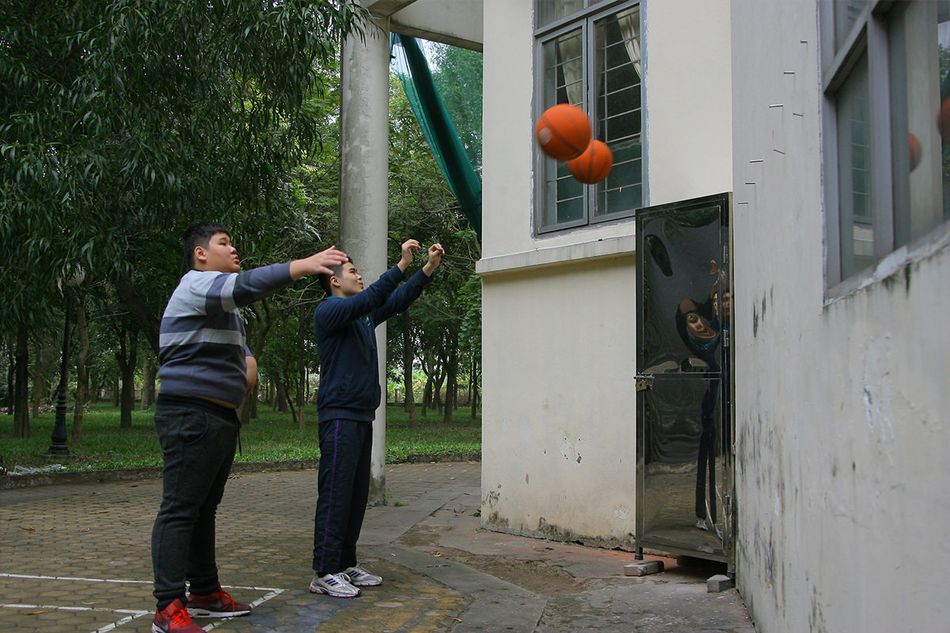Observe public spaces in Saigon for any amount of time and you'll quickly notice many interactions take place in both the physical world and within the virtual sphere. Whether it’s teenagers taking Instagram selfies at Takashimaya or grandmas filming their grandkids on Nguyen Hue, the digital world is integral to daily urban life.
Graham Crist, an associate professor and Architecture program lead at RMIT University Vietnam, has turned this reality into a lecture called “The City is a Chatroom,” to be held at RMIT’s Pham Ngoc Thach campus in District 3 tonight.
“It’s a provocation around the idea that, more and more, the physical environment is in fact simulating the virtual environment,” Crist tells Saigoneer. He argues that university campuses are leading this transformation, offering RMIT’s Melbourne campus as an example.
“RMIT Melbourne is doing a massive redevelopment…and it’s a project called the New Academic Street,” he says. “Nearly all of the spaces that are being built are super flexible, sort of drop-in hub spaces, almost like cafes.”
Walk through this area, Crist explains, and you see students in intimate conversation with people sitting next to them as well as on their laptops and phones.
“It’s a physical version of the kind of interactions we do every day, whether it’s on Instagram or texting friends,” he shares.
Saigon, with its vibrant street culture and countless open-front cafes, bars and restaurants, is another example of this concept, if not by intentional design.
“[Saigon] seems to be a city where that environment is already being built,” Crist says. He points to our meeting place, the Old Compass Café, a casual spot on Pasteur Street which features a communal table and books meant to spark discussions, as a prototype.
“The fact places like this [the cafe] exist, they may be expat-heavy, but in the five years I’ve been coming here there are more bars, cafes and places where those sorts of informal interactions occur.”
The professor also touches on the recent controversy over proposed motorbike bans in Vietnam’s biggest cities, along with Saigon’s rapidly worsening traffic congestion. “This dilemma is that the center of Saigon is so exciting and lively, and would probably be a lot less so if it didn’t have motorbikes running around it,” he shares. “My message, if I had any policy control, would be get rid of the SUVs and keep the motorbikes.”
While it is true that conversation-friendly establishments have spread across the city in recent years, it’s hard to ignore the concurrent rise of closed-off mega-developments such as the Vinhomes projects along the Saigon River. These worry Crist as well.
“There are two ways the city could go, and it will probably continue to go both ways,” he says. “We would see the big-footprint, western podium tower model as just repeating the same mistakes of western cities.” The question, he posits, is how to modernize without necessarily westernizing in terms of design and planning.
The second direction for these changes involves the city continuing to create spaces for personal interactions in the Saigon way. For his part, Crist remains positive regarding this future. “My optimism is that Saigon has a real sense of what it is, in a way that Singapore didn’t, so it just got rid of everything,” he shares. “I don’t think that will happen here.”
Residents also need to believe that designers will make things better, he argues, instead of only tearing things down.
Ultimately, moving down the path of creating physical spaces that mimic the virtual world may lead to the creation of more destinations like Nguyen Hue’s pedestrian street, though ideally not exact replicas.
“If my student designed Nguyen Hue, I’d say ‘you’ve got to be kidding me’,” Crist explains. “But then you see it at night and it’s fantastic…a place like that works as well as it does because there’s so much density around it and such a shortage of open space that people pour into it…so let’s say it’s good, but if that becomes a model for everything then it’s a problem.”
This tension between open spaces and private, walled-off zones will likely remain in place as Saigon continues to rapidly grow and develop, and Crist believes that the physical and the virtual will become more closely intertwined as this happens.
“I think people are starting to realize that in no way is the digital world replacing the physical environment,” he says. “The virtual world of social media and the physical environment that we’re in are completely complimentary. It’s just that the kind of spaces we use are different."
[Image via Flickr user Gavin]














